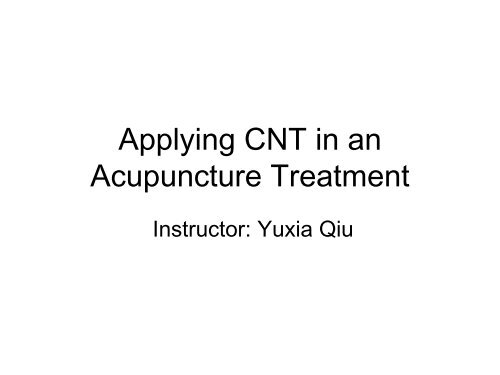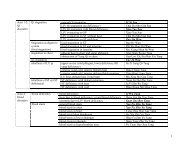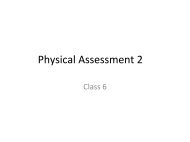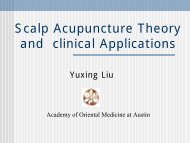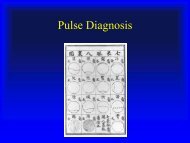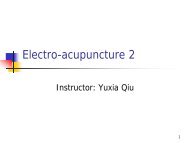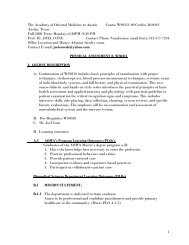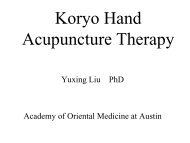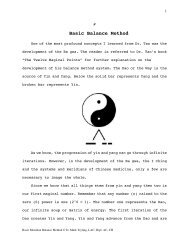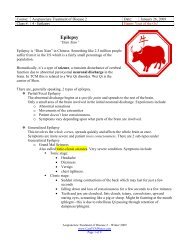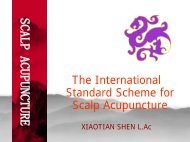Applying CNT in an Acupuncture Treatment - CatsTCMNotes
Applying CNT in an Acupuncture Treatment - CatsTCMNotes
Applying CNT in an Acupuncture Treatment - CatsTCMNotes
Create successful ePaper yourself
Turn your PDF publications into a flip-book with our unique Google optimized e-Paper software.
Position<strong>in</strong>g the patient• <strong>in</strong> a posture suitable to the po<strong>in</strong>ts selected.– Sup<strong>in</strong>e: po<strong>in</strong>ts of• the frontal <strong>an</strong>d facial regions,• chest <strong>an</strong>d abdomen• The <strong>an</strong>terior or lateral aspect of the lower extremities– Prone:• Occipital• Neck• Lumbodorsal regions• Posterior aspect of the lower extremities– Lateral recumbent:• Lateral aspect of the body– Sitt<strong>in</strong>g• Head, back <strong>an</strong>d upper extremities
H<strong>an</strong>dwash<strong>in</strong>g• H<strong>an</strong>dwash<strong>in</strong>g is the most import<strong>an</strong>t s<strong>in</strong>gleprocedure for prevent<strong>in</strong>g <strong>in</strong>fection <strong>in</strong> a health caresett<strong>in</strong>g.• When to wash h<strong>an</strong>ds:– Before a treatment– Immediately before the acupuncture procedure– After contact with blood or body fluids or obviousenvironmental contam<strong>in</strong><strong>an</strong>ts– Whenever their h<strong>an</strong>ds become contam<strong>in</strong>ated dur<strong>in</strong>g atreatment.– Between patients– At the end of a treatment– After remov<strong>in</strong>g PPE
How to wash h<strong>an</strong>ds– Wash the entire surface of the h<strong>an</strong>ds between the f<strong>in</strong>gers, around <strong>an</strong>dunder the f<strong>in</strong>gernails <strong>an</strong>d up to above the wrist.– Lower the h<strong>an</strong>ds so that water <strong>an</strong>d soap dra<strong>in</strong> off the f<strong>in</strong>gertip as theyare r<strong>in</strong>sed.– Soap <strong>an</strong>d wash h<strong>an</strong>ds twice under runn<strong>in</strong>g water for at least 10seconds.– Turn off the tap with a towel or use <strong>an</strong> elbow so that h<strong>an</strong>ds do notbecome soiled.– Particular attention should be paid to f<strong>in</strong>gernails, which should be keptshort <strong>an</strong>d cle<strong>an</strong>.– When there is no s<strong>in</strong>k available, alcohol-based h<strong>an</strong>d dis<strong>in</strong>fect<strong>an</strong>t,<strong>an</strong>tiseptic h<strong>an</strong>d cle<strong>an</strong>sers or towelettes c<strong>an</strong> be used for h<strong>an</strong>dwash<strong>in</strong>g.– If h<strong>an</strong>ds are contam<strong>in</strong>ated after wash<strong>in</strong>g, the f<strong>in</strong>gertips should becle<strong>an</strong>ed, <strong>an</strong>d swabb<strong>in</strong>g with alcohol or us<strong>in</strong>g <strong>an</strong> alcohol-based h<strong>an</strong>drub, germicidal scrub or <strong>an</strong>tiseptic towelette is acceptable substitute.– Germicidal soap or <strong>an</strong> alcohol-based h<strong>an</strong>d dis<strong>in</strong>fect<strong>an</strong>t should be usedfor immuno-compromised patient.
Prepar<strong>in</strong>g the site for <strong>in</strong>sertionof a needle• Check that the sk<strong>in</strong> areas to be treated are free of <strong>an</strong>y cuts, wounds,or diseases.• Ensure that the part of the body to be treated is cle<strong>an</strong>– 70% alcohol is used for prepar<strong>in</strong>g a patient’s sk<strong>in</strong> <strong>in</strong>stead of 90%– Iodophor such as betadyne followed by alcohol swab or benzylconiumchloride is recommended for immunocompromised patients.– Swab the po<strong>in</strong>ts <strong>in</strong> a way that touches the area only once so as not torecontam<strong>in</strong>ate the area– The same swab may be used for po<strong>in</strong>ts <strong>in</strong> the same general area.– The alcohol should be allowed to dry.• To reduce discomfort on needl<strong>in</strong>g• To reduce possibility of <strong>in</strong>ject<strong>in</strong>g m<strong>in</strong>ute amounts of contam<strong>in</strong><strong>an</strong>ts suspend<strong>in</strong> the alcohol• The longer the alcohol has to act, the more effective the <strong>an</strong>tiseptic.
Palpat<strong>in</strong>g the po<strong>in</strong>t• It is acceptable cle<strong>an</strong> technique to touch theacupuncture po<strong>in</strong>t after cle<strong>an</strong><strong>in</strong>g the sk<strong>in</strong>, aslong as the h<strong>an</strong>ds have not been contam<strong>in</strong>ated.• Before pick<strong>in</strong>g up the needle or palpat<strong>in</strong>g thepo<strong>in</strong>t, h<strong>an</strong>ds should be washed aga<strong>in</strong> if theyhave been contam<strong>in</strong>ated s<strong>in</strong>ce the lasth<strong>an</strong>dwash<strong>in</strong>g.
Us<strong>in</strong>g sterile needles• It is critical that the needle shaft be ma<strong>in</strong>ta<strong>in</strong>ed <strong>in</strong> asterile state prior to <strong>in</strong>sertion.• When open<strong>in</strong>g a needle packet, ensure that theneedle shaft does not touch the part of the packetthat was touched by the f<strong>in</strong>gers while open<strong>in</strong>g thepacket.• Needle <strong>in</strong>sertion <strong>an</strong>d m<strong>an</strong>ipulation must beperformed without the practitioner’s bare h<strong>an</strong>dscom<strong>in</strong>g <strong>in</strong>to contact with the shaft of the needle.– If the needle shaft must be supported, a sterile gauze pad orcotton ball should be used <strong>in</strong>stead of cle<strong>an</strong> one
Us<strong>in</strong>g Guide tubes• Guide tubes should be sterile at the beg<strong>in</strong>n<strong>in</strong>g ofeach treatment on each patient.– It is considered acceptable to use the tube repeatedlyon the same patient.• If a guide tube is used, dropp<strong>in</strong>g the needle <strong>in</strong>tothe tube h<strong>an</strong>dle first.• If guide tubes are used, they should be placedon the cle<strong>an</strong> field between uses.
Us<strong>in</strong>g gloves• The use of gloves is strongly recommended<strong>in</strong> the follow<strong>in</strong>g <strong>in</strong>st<strong>an</strong>ces:– Dur<strong>in</strong>g procedures such as bleed<strong>in</strong>g where there is a greaterrisk of contact with larger amounts of blood.– When work<strong>in</strong>g with patients who have open lesions orweep<strong>in</strong>g exudates from their sk<strong>in</strong>.– When the practitioner has cuts, abrasions, chapped sk<strong>in</strong>,h<strong>an</strong>g nails or broken cuticles on his or her h<strong>an</strong>d <strong>an</strong>d thelesions are located <strong>in</strong> a location where they pose a hazard.– When palpat<strong>in</strong>g or needl<strong>in</strong>g <strong>in</strong> the mouth or genital area.
The “no”s about gloves• The use of gloves is not necessary dur<strong>in</strong>grout<strong>in</strong>e acupuncture practice <strong>in</strong> theabsence of signific<strong>an</strong>t bleed<strong>in</strong>g.• Glov<strong>in</strong>g will not stop direct puncture<strong>in</strong>juries.– Gloves present a barrier only to blood <strong>an</strong>dother potentially <strong>in</strong>fectious fluids.– Only proper h<strong>an</strong>dl<strong>in</strong>g of contam<strong>in</strong>ated needleswill prevent needlestick.
Ensure the gloves are protective• Disposable gloves shall be replaced:– As soon as practical when contam<strong>in</strong>ated– As soon as feasible if they are torn, punctured,or when their ability to function as a barrier iscompromised
M<strong>an</strong>ag<strong>in</strong>g used <strong>in</strong>struments• Used needles should be isolated until they aresterilized or discarded.• The sharps conta<strong>in</strong>er should be replaced when it isthree-quarters full.• M<strong>an</strong>agement of used-needle spill:– Use gloves <strong>an</strong>d tweezers for pick<strong>in</strong>g them up– The spill area should be cle<strong>an</strong>ed with soap <strong>an</strong>d water.– All exposed surfaces should be wiped with a germicide suchas bleach.– All materials used <strong>in</strong> the cle<strong>an</strong>-up job should be discarded <strong>in</strong>double wrapp<strong>in</strong>g.– H<strong>an</strong>dwash<strong>in</strong>g.
Bleed<strong>in</strong>g dur<strong>in</strong>g cupp<strong>in</strong>g• What to do if bleed<strong>in</strong>g occur dur<strong>in</strong>g cupp<strong>in</strong>g:– Gather gloves <strong>an</strong>d cle<strong>an</strong><strong>in</strong>g materials– Put on gloves– Remove the cups, tak<strong>in</strong>g care to prevent body fluid fromspread<strong>in</strong>g or splash<strong>in</strong>g– Stop the bleed<strong>in</strong>g through use of appropriate pressure.– Cle<strong>an</strong> up <strong>an</strong>y bleed<strong>in</strong>g that has occurred.– Immediately isolate the cups– H<strong>an</strong>dle <strong>an</strong>d dispose of all materials used <strong>in</strong> the cle<strong>an</strong><strong>in</strong>gprocess as biohazardous waste– Sterilize the cups us<strong>in</strong>g a double sterilization procedure withchemical dis<strong>in</strong>fect<strong>an</strong>ts.• Disposable, plastic <strong>an</strong>d rubber cupp<strong>in</strong>g devices thatc<strong>an</strong> not be sterilized should be used on only onepatient.
Cle<strong>an</strong><strong>in</strong>g a spill of blood or bodyfluid• Wear disposable, waterproof gloves• Cle<strong>an</strong> the spill once with soap <strong>an</strong>d water.• Wipe all exposed surfaces with a germicide.• All materials used <strong>in</strong> the cle<strong>an</strong>-up job should bediscarded <strong>in</strong> double wrapp<strong>in</strong>g.• Wash h<strong>an</strong>ds at the end of the cle<strong>an</strong> up.
Dispos<strong>in</strong>g of biohazardouswaste• Biohazardous waste:– Any solid waste or liquid waste that may present athreat of <strong>in</strong>fection to hum<strong>an</strong>s• Discarded sharps (used needles)• Hum<strong>an</strong> blood• Cl<strong>in</strong>ic waste such as table paper or cotton balls that conta<strong>in</strong>hum<strong>an</strong> blood• Body fluids• Non-liquid hum<strong>an</strong> tissue <strong>an</strong>d body parts• Hum<strong>an</strong> blood products• Laboratory disease-caus<strong>in</strong>g agents
• Biohazardous waste, except sharps,must be packaged <strong>in</strong> impermeable, red,polyethylene or polypropylene bags,<strong>an</strong>d sealed.• Discarded sharps must be separatedfrom all other waste <strong>an</strong>d placed <strong>in</strong> leakresist<strong>an</strong>t,rigid, puncture-resist<strong>an</strong>tconta<strong>in</strong>ers.• All conta<strong>in</strong>ers must be labeled properly.


